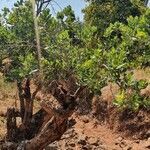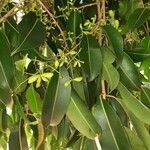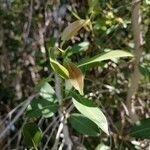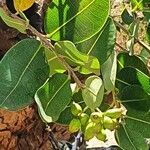Trees, shrubs or pyrophytic subshrubs 0.2–30 m tall with smooth or rough bark; sometimes buttressed; young branches ± terete or somewhat 4-angled, mostly only strongly 4-angled in hybrids with S. cordatum.. Leaves elliptic, oblong-elliptic or elliptic-lanceolate to obovate-elliptic, (3–)4–16 cm long, 1–7.7 cm wide, acute to acuminate to broadly rounded, subtruncate or even emarginate at the apex, cuneate at the base; petiole 0.6–2.5(–4.5) cm long.. Inflorescence short to extensive, 5–19 cm long.. Calyx-tube with pseudopedicels usually distinct.. Filaments 3.5–9 mm long.. Fruits variously red or purple, subglobose or ellipsoid, 0.8–3.5 cm long, 0.6–2.5 cm wide.
Leaf-lamina 4 x 2–14 x 7 cm., very variable in shape, broadest at or near the middle, apex obtuse to acuminate, base cuneate; petiole 0·2–2·2 cm. long.
Receptacle (including pseudopedicel) + calyx 0·35–0·65 cm. long; calyx +upper receptacle 0·15–0·25 cm. long; filaments 0·35–0·9 cm. long.
Small or medium-sized (elsewhere a large) evergreen tree or a suffrutex.
Fruit subglobose or ellipsoid, 1·3–3·5 x 1·2–2·5 cm.





